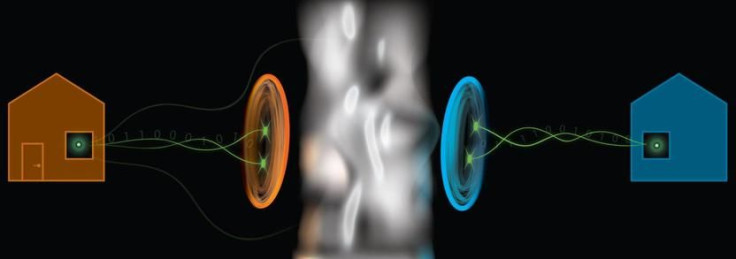Quantum Teleportation: Einstein's 'Spooky Action At A Distance' Could Improve Cybersecurity

Physicists describe the phenomenon of “action at a distance” as the perceived effects on an object without there being any form of touch to transfer energy by another object. It is the interaction between two objects not connected to each other. Albert Einstein described the phenomenon as "spooky action at a distance" and it has fascinated us since Roald Dahl’s Matilda made the Cheerios box to tip over with just her mind.
Now a team of physicists have figured out a method to rigorously test if pairs of photons — particles of light — display this "spooky action at a distance" effect even under adverse conditions outside a lab setting. This could greatly improve internet security, data security concerns and privacy in general by helping in detecting attacks by hackers. The study was conducted by a team from Griffith University, Centre for Quantum Dynamics in Australia.
As photons travel through an optic fiber medium carrying information, some of them gets scattered. As they travel through longer distances, more get lost. Information sent via photons are lost during high-speed transfer. These photons can then be easily be intercepted and the data that was sent can easily be decoded by hackers.
"As the length of quantum channel grows, less and less photons successfully pass through the link, because no material is perfectly transparent and absorption and scattering take their toll,” said team leader Professor Geoff Pryde in a statement.
An effect known as quantum nonlocality — two quantum systems (computers) linked together — is seen as the integral property that helps gauge security during data transfer between two computers. It involves checking the data sent and received to check if the information reach the destination.
Two “entangled” photons are used in data transfer systems that are linked together between two locations where the transfer needs to occur. These pairs of photons are "entangled" so that measuring one determines the properties of its twin.
This means that even when interactions between two nonlocal (entangled) photons are verified, it does not account for many of the photons lost by absorption or scattering as they travel from source to destination through an optical fiber channel. It just shows the successful information relay between the source and destination which confirm the transfer but the real question is, was it secure?
The loss of photons is a problem for existing quantum nonlocality verification techniques in gauging security concerns. Every photon lost makes it easier for a potential hacker to break the security by gaining knowledge of the nature of the photons and mimicking it. Here is where entanglement kicks in.
If scientists can test entanglement when there is a data loss, it can easily tell them if there is a difference in the information between two points and if photons have been lost. But, it is not so easy. Developing a method to test entanglement in presence of loss has been a challenge for the scientific community for quite some time.
To test the entangled photons, the team came up with an approach — called quantum teleportation — which helped them study quantum entanglement even in high-loss systems.
Dr. Morgan Weston, first author of the study said the team chose few photons that survived the high-loss channel and reached the destination without getting scattered. These photons were then “teleported” into another clean and efficient quantum channel where they were subjected to the usual quantum steering tests to determine the interaction or entanglement even when losses were suffered in the earlier system.
"There, the chosen verification test, called quantum steering, could be done without any problem," Weston said.
"Our scheme records an additional signal that lets us know if the light particle has made it through the transmission channel. This means that the failed distribution events can be excluded up front, allowing the communication to be implemented securely even in the presence of very high loss," she added.
The teleportation step involves the use of high-quality photon pairs on its own. These extra photon pairs have to be generated and detected with extremely high efficiency, in order to compensate for the effect of the lengthy transmission line where the researchers saw losses. But putting them in an ideal system helped the researchers study quantum entanglement.
With this method, the team were able to test channels with photon absorption equivalent to about 80 km of telecommunications optical fiber. The study was published in the journal Science Advances on Jan. 5.
© Copyright IBTimes 2025. All rights reserved.




















